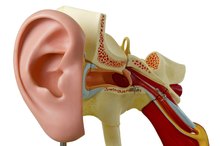Ear Cartilage Infection Symptoms
The outer ear is made up of cartilage. The thin layer of tissue surrounding the cartilage is called perichondrium. Perichondritis is infection of the skin and tissues surrounding the cartilage of the ear 12. Initially, ear cartilage infection appears like a skin infection. Later, the infection spreads to the perichondrium. Perichondritis occurs usually after injury or trauma to the cartilage, inappropriate ear piercing through the cartilage, surgery of the outer ear and boils on the ear 12. The bacteria Pseudomonas and Staphylococcus aureus are commonly involved
Pain, Swelling and Redness
The signs of inflammation will be present with perichondritis 12. A painful and red ear is the most common symptom of ear cartilage infection, according to the National Institutes of Health. Pain will occur in the cartilage portion of your ear. The redness surrounds the area where the injury has occurred. Ear lobe swelling can occur with an infection of the ear cartilage.
- The signs of inflammation will be present with perichondritis 1.
- A painful and red ear is the most common symptom of ear cartilage infection, according to the National Institutes of Health.
Changes in Shape
How to Get Rid of an Ear Lobe Infection
Learn More
Pus can collect between the cartilage and surrounding perichondrium with a severe infection. This pus collection can sometimes result in the death of the cartilage, according to The Merck Manuals 2. This happens because the cartilage receives its blood supply and nutrition from the perichondrium. This can lead to a deformed ear. An untreated severe infection of the ear cartilage can change the shape of the ear and result in cauliflower-shaped deformity of the ear.
- Pus can collect between the cartilage and surrounding perichondrium with a severe infection.
- An untreated severe infection of the ear cartilage can change the shape of the ear and result in cauliflower-shaped deformity of the ear.
Discharge
Severe cases of ear cartilage infection will result in fever, discharge seeping from the wound and itching of the ear. A severe ear cartilage infection will cause crusts in the affected area and pus like discharge. The infection from the ear can spread to soft tissues of the face and neck, according to University of Texas Medical Branch. If you have the above symptoms of ear cartilage infection, seek immediate medical attention to prevent complications.
- Severe cases of ear cartilage infection will result in fever, discharge seeping from the wound and itching of the ear.
- A severe ear cartilage infection will cause crusts in the affected area and pus like discharge.
Related Articles
References
- Medline Plus: Perichondritis
- The Merck Manuals: Perichondritis
- Merck Manual. Perichondritis. August 2019.
- Merck Manual. Relapsing polychondritis. April 2018.
- Yahalom S, Eliashar R. Perichondritis: a complication of piercing auricular cartilage. Postgrad Med J. 2003;79(927):29. doi:10.1136/pmj.79.927.29
- Borgia F, Giuffrida R, Guarneri F, Cannavò SP. Relapsing polychondritis: an updated review. Biomedicines. 2018;6(3). doi:10.3390/biomedicines6030084
- Brant, JA, Ruckenstein, MJ. Cummings Otolaryngology: Infections of the External Ear. 6th ed. 2015;137:2115-2122.e2.
- Diagnosis and management of foreign bodies of the outer ear. Updated January 13, 2017.
Writer Bio
Vaishali Mehta is a doctor by profession and has a master's degree in otolaryngology from India. She has clinical experience in the field of ENT. She has a passion for medical writing and has written stacks of research articles. She likes to write for health, fitness and nutrition, and otolaryngology-related topics.







